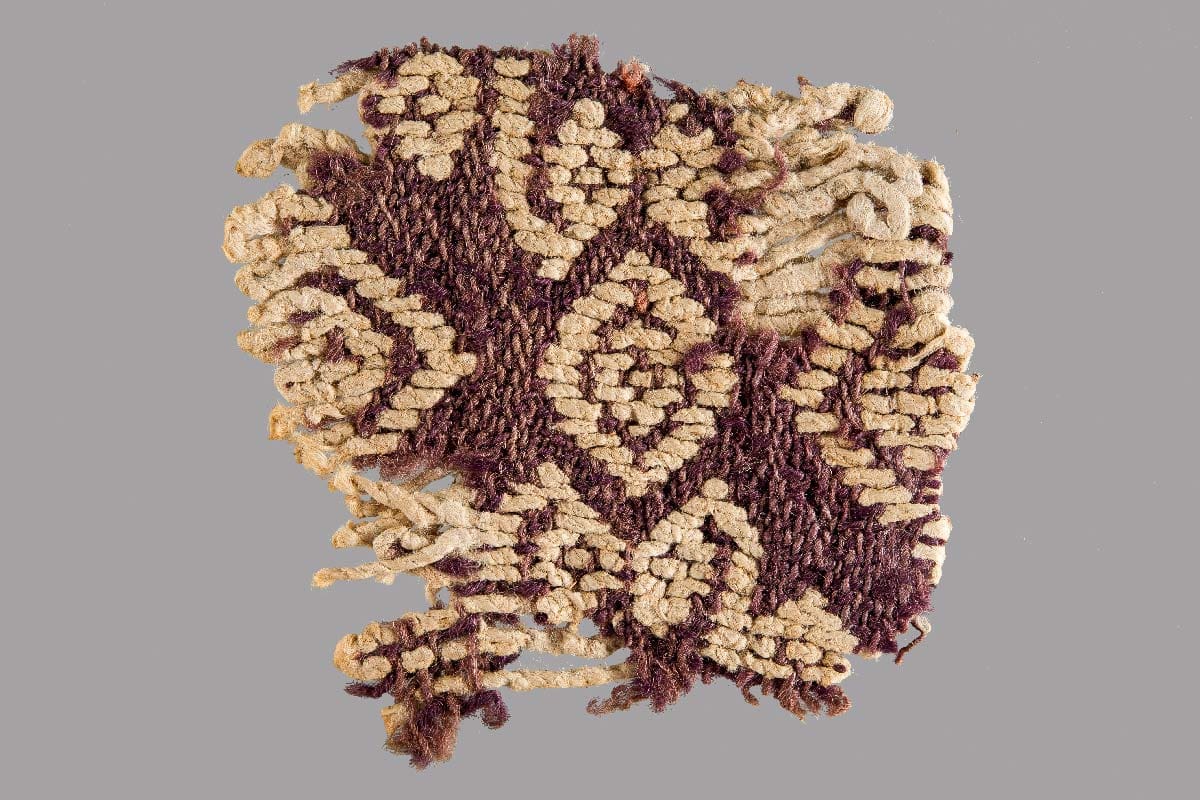The Roman House at Hopkins | Creating Comfort: Furnishing Textiles in Roman Domestic Spaces
Fragment of a Bedcover or Rug
By Betsy Bevis

Measurements: Length: 7.6cm, Width: 6.4cm
Material: Wool
Culture/Date: Roman, 3rd – 6th c. CE?
Provenance: Egypt, On loan from Eton College Myers Collection
This small textile fragment has a purple ground and a pattern of diamonds and geometric fretwork, similar in appearance to the hooked lozenges on modern folk textiles of the Middle East and Eastern Europe. The geometric pattern on this piece is executed in a heavy white wool(?) thread in a brocade technique. The warp and weft are finer threads of purple wool.
Close inspection of the textile fragment reveals that the purple ground consists of warps and wefts of two different shades of purple. The weft threads are a dark, reddish purple while the warp threads are a lighter, grayed violet. Inspection under UV light confirms the presence of two different types of dye, as the weft threads fluoresce and the warp threads do not. Further chemical testing would be required to say with any certainty what dyes were used on this textile, but some possibilities include “Tyrian” or “Imperial” purple derived from the murex family of mollusks, a red dye (madder, cochineal, or kermes) over-dyed with indigo, or a purple derived from other substances such as elderberries or the orchil family of lichens.
Murex purples are famous as the most expensive and coveted dyes of antiquity. Each shellfish produces only a tiny amount of the fluid that must be laboriously processed to obtain the purple dye. Therefore, people developed many strategies for extending and imitating murex purples to reduce the price of purple textiles. This fragment appears to be an example of some of these strategies in use.
Even economized, as this fragment appears to have been, an entire purple textile would have been a bold statement of conspicuous consumption in a domestic setting. When it was whole, this piece appears to have been particularly heavy and dense, and so it was more likely a bed cover or light rug than a curtain or a garment. While Egypt is known for its desert heat, winter nights can be quite chilly therefore warm bedcovers are a necessity for part of the year. Likewise, if this piece were used as a rug, it could soften and warm a chilly floor as well as provide visual definition to a specific area within a room.
Comparanda – The trim on the sleeve of Louvre AF 6032 is almost identical, in spite of being part of a garment. Published in Cortopassi, R. 2005. “Late Roman and Byzantine Tunics in the Louvre Museum.” In Ancient Textiles: Production Craft and Society edited by C. Gillis and M.-L. Nosch, 139-142. Cortopassi mentions how unusual it is for this textile fragment to be incorporated in a piece of clothing (Cortopassi 2005, 141.)